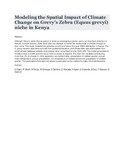| dc.contributor.author | Kigen, C. | |
| dc.contributor.author | Okoth, Patrick | |
| dc.contributor.author | Konje, Martha | |
| dc.contributor.author | Shivoga, W. | |
| dc.contributor.author | Ochieno, Dennis | |
| dc.contributor.author | Wanjala, S. | |
| dc.contributor.author | Agevi, H. | |
| dc.contributor.author | Onyando, Z. | |
| dc.contributor.author | Soy, B. | |
| dc.contributor.author | Kisoyan, P. | |
| dc.contributor.author | Makind, S. | |
| dc.date.accessioned | 2023-10-09T10:14:40Z | |
| dc.date.available | 2023-10-09T10:14:40Z | |
| dc.date.issued | 2013-09-02 | |
| dc.identifier.uri | http://ir-library.mmust.ac.ke:8080/xmlui/handle/123456789/2356 | |
| dc.description.abstract | Although Grevy’s zebra (Equus grevyi) is listed as endangered species and is an important attraction in Kenya’s tourism industry, there have been no attempts to model the implications of climate change on their niche. This study modeled the potential current and future (the year 2080) distribution in Kenya. The E. grevyi location data were sourced from published literature and climate data was downloaded from world climate database website and analysis done using MaxEnt and DIVA-GIS. The model generated an excellent AUC of 0.984 and the future niche is shown to expand. The main five variables contributing more than 2% of change in niche expansion are isothermality, precipitation of coldest quarter, annual mean temperature, annual precipitation, min temperature of coldest period and precipitation of wettest quarter. The generated information will assist conservation policy makers to make informed decisions. © 2013 Elixir All rights reserved ARTICLE INF O Articl e h istory: | en_US |
| dc.language.iso | en | en_US |
| dc.publisher | Environmental Science | en_US |
| dc.subject | Modeling,Spatial, Impact, Climate Change, Grevy’s Zebra, (Equus grevyi), niche | en_US |
| dc.title | Modeling the Spatial Impact of Climate Change on Grevy’s Zebra (Equus grevyi) niche in Kenya | en_US |
| dc.type | Article | en_US |

